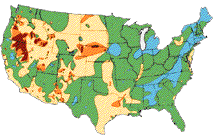|
Geothermal energy derives from the immense thermal reservoir of
the earth's interior. Heat from molten rock (magma) beneath the
earth's crust or from natural radioactive decay transfers to rock and
water closer to the surface. In certain regions of the earth, the hot
waters are close enough to the surface to be commercially exploited
in heating applications, or, in the case of high-grade steam
reserves, in electrical power generation.
One question that commonly arises regarding geothermal energy is
whether or not it is a renewable resource. The answer hinges on how
the resource is developed. Certainly the heat within the earth, like
the sun, is limitless compared to human activity. However, the waters
that are tapped in geothermal development are finite. Hydrothermal
(hot water) aquifers will be diminished whenever water is withdrawn
faster than it is recharged. Overexploitation at some facilities in
California, for example, resulted in a lower than expected output. If
water is reinjected into the field after extracting heat (as is done
in some locations), then the resource may be said to be truly
renewable. Otherwise, it is simply mined, much as a petroleum
reserve.
Areas with significant geothermal resource occur where the earth's
crust is relatively thin, such as along the boundaries of tectonic
plates. Geysers, hot springs, volcanoes, and seismic activity, all of
which are noticeably absent in Texas, mark such regions. In the U.S.,
the best geothermal resources occur along the Pacific rim (California
to Alaska) and in Hawaii (see Figure 13). California has the largest
geothermal electric facilities in the nation, with about 1100 MWe,
most concentrated at the Geysers steam field in the northern part of
that state.

| GEOTHERMAL GRADIENT (degrees C/km) |
 0-14 0-14
 15-29 15-29 |
 30-44 30-44
 45-59 45-59 |
 60+ 60+ |
FIGURE 13. Geothermal Gradient Contour Map
of the United States.
The increase in temperature with depth below the ground is highest
in areas with volcanic and seismic activity. This map indicates Hot
Dry Rock potential.
A significant portion of the energy consumed in the United States
requires relatively low temperatures. Energy needed for space and
water heating, fish farming and greenhouse heating, enhanced oil
recovery, and desalinization can take advantage of low temperature
hydrothermal resources if such resources are present where the energy
is consumed.
Texas does not possess any easily accessible field with the high
temperatures required for electric power generation. It does,
however, possess some low-temperature hydrothermal reserves that have
seen limited use. As shown in Figure 14, these resources occur mainly
in two bands, one that cuts a swath through the central part of the
state, and a second that borders the Rio Grande in the Trans-Pecos.
Temperatures in the Central Texas hydrothermal aquifers range from
about 90° to 160°F at depths from 500 to 5,000 feet.
Historically the waters have seen some application in spas and
therapeutic baths. Where waters are potable, a number of smaller
communities have tapped them for their municipal supply, without
making use of the heat. A recent project in Marlin, however, employed
geohermal well water to heat a local hospital. In the Trans-Pecos,
thermal waters have likewise supplied resort baths, with scant need
for more extensive development owing to the region's remoteness.
| TEXAS GEOTHERMAL AREAS, CHARACTERS AND USES |
| HYDROTHERMAL |
GEOPRESSURE |
HOT DRY ROCK |
 |
 Known Known |
 Known Known |
 Known Known |
 Potential Hydrothermal or Geopressure Source Potential Hydrothermal or Geopressure Source |
 |
- 90 - 160 °F Water
(500-5,000 ft. deep)
- In some cases Water is Potable
|
- 300 - 450 °F Brine
(>13,000 ft. deep)
- High Pressure
- Dissolved Methane
|
- Gradient > 45 °C/km
- Little or No Water
|
 |
- Space Heating
- Fish Farming
- Desalinization
- Resort Spas
|
- Heating
- Enhanced Oil Recovery
- Electricity
|
|

FIGURE 14. Texas Geothermal Resource Areas.
Hydrothermal, geopressured, and hot dry rock resource areas are identified; characteristics and uses for each are listed in the legend.
In addition to the state's low-temperature hydrothermal resource,
large zones of hot, highly pressurized fluids occur in deep strata
under the Gulf Coast. This so-called "geopressured-geothermal"
resource was studied extensively in the 1970's and 1980's and a test
well was operated by the Department of Energy at Pleasant Bayou near
Houston. Typically, geopressured zones are at depths on the order of
15,000 feet and the fluid itself is a hot (about 300 deg. F),
high-pressure brine with methane dissolved in it. Interest in the
resource is probably driven as much by the potential methane recovery
as by its geothermal character. To date, development has not proven
economical. Hot brine, however, may someday be used in enhanced oil
recovery schemes. Since the resource is not renewable, it must be
mined to be used.
A final, long-term geothermal energy prospect is the extraction of
heat from zones of "hot dry rock" (HDR). In the envisioned HDR
facility, high-pressure water injected underground at one point is
collected at a distance well after it has been heated by passing
through fractured, hot rock. The scheme is presently in its infancy.
One study suggested that Texas has moderately good resource in the
eastern part of the state (see Figure 13).
Texas does not have the sort of readily accessible,
high-temperature hydrothermal resource that can be used to generate
electricity. The resource in the central part of the state can,
however, have an impact in low-temperature applications such as space
heating or aquaculture. Several municipalities that presently
introduce warm aquifer water in drinking supplies could capture
beneficial heat with the addition of a heat exchanger. The
geopressured-geothermal resource will become more attractive only in
the context of higher energy prices. Hot dry rock's potential value
is presently unknown.
|



